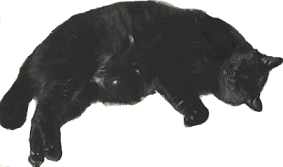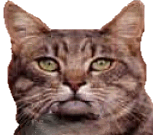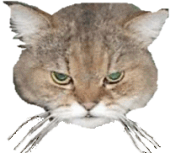Body Language

Have you ever heard the owner of a pet saying 'I wish I knew what he wanted' or 'what she is thinking'? Well the fact is that our pets talk to us all the time. We just need to learn what they are trying to say. Cats don't vocalize much, although they have a vocabulary of sounds. Their main communication is through body language. Actually, cats use sound mostly to communicate with humans, and much less with other animals.
Meowing is probably something cat learn. We talk to our furry friends all the time, so they too have developed a 'voice' to express themselves to us. We won't spend too much time on the subject of cat's vocalization, but I it is important to briefly mention three or four sounds. A standard 'Meow' is a general signal that a cat wants our attention. Sometimes cats wanting attention will politely 'meow' almost without making any sound at all (though ignoring this may lead to a rapid escalation in sound levels!). A quick 'chirrip' meow is a greeting. The well known 'purr' usually means 'I am content and happy'. But we should remember that a cat will also purr when it is in pain. Cats purr when they are emotional; whether happy or in distress - in some ways purring is also a way to seek attention and aid. 'Hisses' and 'growls' are used when a cat is threatened and challenged. This is the cat's way to warn others to back off - and this is not a good time to approach and pat the cat, even to reassure it. The hiss and growl may not be directed toward you, but the cat may release her aggression by snapping at your hand.
Most of a cat's communication is through body language. Ears, tail, legs, posture and eyes are all talking, giving us and other members of the animal kingdom clear messages. By observing cats in the wild, and domestic cats under different conditions, experts have learned a lot about the body language of cats. But there is no doubt that there are much more subtle signals which we have not discovered yet. So just as cats watch and try to understand us, we should watch them and learn. The description which we included below is by no means a full set and I am sure that we will be adding some new material as we learn more about our furry friends. (And remember, just as with humans, body language can vary among individuals - so the secret is - Know Your Cat!)
Posture
Since we are talking about body language, let's start with general posture. An upright posture with the head held high indicates a confident and content cat. When the cat lowers her head and turns it sideways, avoiding eye content it indicates lack of interest and non-aggression. In the presence of danger (e.g. a strange cat trespassing on their territory) , the cat's head will move down and her back will start arching, getting ready to attack if the need arises. Some cats will lower themselves to the ground with their front paws in before them and back legs firmly underneath.
When a cat is hunting it will start by quietly lying down with the forelegs in front and the back legs under the body. As she is getting ready to jump on the prey, her backside goes up with the head almost flat on the ground. The cat's head will move from side to side to get a better feel for the exact distance between her and the prey.
A very relaxed cat will lie on her side or back with legs spread outwards. You almost never see a cat in this position if the cat is not fully at home with her surroundings. This is also an indication that the cat may allow you to stroke her tummy. It is a sign of trust.
Ears

Attentive - ears pointed, whiskers sraight
A cat's ears are very mobile. Cats have over 20 muscles controlling them and they can literally turn the ears through 180 degrees. The position of the ears are a very good indication of cat's mood. The ears straight up slightly facing forward and the whiskers relaxed are the signs of a happy and alert cat. If you now start stroking her the whiskers may move slightly forward, and the eyes will half close - this with a soft purr will tell you that she is a very content cat.
When the cat is nervous the ears will start moving sideways and the whiskers will drop down. As the cat starts feeling more uneasy the ears will start moving further back. An angry and frightened cat will put her ears flat facing sideways or back. It is not unusual for a nervous cat to trot away with her ears turned back 'facing' the threat as a kind of early warning system.
Of course the movement of the ears is not always an indication of cat's mood. After all, the ears are mainly for listening. So the cat will turn her ears towards the incoming sound. Because the ears can move independently you can often see one ear facing forward as the other moves sideways to get a better reception.
Tail
The important thing to remember is that when the cat wags her tail, she is angry, not as some people think, pleased. This the the exact opposite to dogs. When a cat is pleased to see you she will put her tail straight up. The ultimate in happiness is a tail bolt upright and quivering. As the cat become more alert the tail goes down. So for example, the cat will walktail up in the house in your company where all is well and safe, but out in the garden the tail will drop to the neutral position.This could be more or less level with her back or further down, but straight, which indicates a neutral to a slightly aggressive posture. As the cat becomes more aggressive her tail will be facing down but with a definite kink at the base. You can often observe this shape when the cat is chasing after something. We have already mentioned the tail slashing backwards and forwards. That is a warning to back off and more vigorous the slashing, more excited and aggressive the cat is.
A 'bottle-brush' tail - tail up and bushy - indicates an angry, emotionally charged cat. You will often see it after argument with the cat next door. Very often the cat's coat on the back will also be standing up. The message is clear - I want to seem much bigger than I am.
When the cat lies on her side or is sitting down and the tail twitches slightly it normally means 'I am interested, ready to play'.
Eyes

Unhappy - ears pointed sideways and flattend, whiskers drooping
Eyes are another organ which cats use for communication. Cats with eyes fully open and looking straight at you want to say "I am listening". Half closed eyes means 'I am sleepy and content'. A cat's eyes are very big, and the pupils can expand to take up almost the entire area of the eye. This is useful for night vision, allowing the cat to absorb the maximum amount of existing light. When there is plenty of light, the cats pupils will narrow to a slit. So correct reading of the eyes is not very straightforward. But in general, a calm content cat in day time will have slit-like eyes. But as soon as the cat becomes uneasy, its pupils will expand to allow it to take in more of its surroundings.
However, a cat's pupils will also expand when she is excited, so for example the excitement of seeing her people after their absence will result in dilated eyes.
The important thing to remember on the subject of eyes is that cats regard eye contact as aggressive. So two rival cats will try to out-stare each other to resolve the conflict. Staring directly into cats eyes will always be interpreted as an aggressive behavior. Have you ever wondered why, when there is a group of people and the cat wanders in, it will choose to sit on the lap of the only person who does not like cats? The answer is very simple. Most people when they see a cat, look at her, and try to pet her to show her how much she is liked. But the effect on the cat is the opposite: the cat thinks 'why is this person so aggressive towards me?' and then chooses the company of the one person who offers no threat.
The other interesting thing is cat's communication through blinking. Try doing an experiment. Sit next to your cat when she is fully relaxed, and then slowly close and open your eyes. Watch the cat doing the same. What you have both said is 'Hi, I like you'.
Head

Angry - ears and whiskers back, eyes narrow, pupils wide
We have already covered some aspects of head movement, but I will iterate briefly here. A cat holding her head up is a content and confident cat. At the sight of danger the head goes down. When the cat wants to a show lack of interest or say 'I am not aggressive' it will turn its head sideways. But there are other important ways the cat communicates with you. When you stroke your cat she will raise her head up to expose the area of the neck where she wants to be stroked. This is one of the areas of cat's body where pheromones are present. By stroking a cat under her chin you transfer some of the pheromones on your hands. The pheromones are also present in the cheek pouches, and again by rubbing herself against you the cat transfers her pheromones on you. This is an affectionate gesture to indicate that you are her friend. The same applies when the cat raises her rear while being stroked. This is another of gesture which means 'I want to be your friend'. What the cat expects you to do is to smell it -again the principle is the same - there are pheromones around cat's anal glands. Of course, our sensitivities mean we do not take up this friendly offer, but from the cat's point of view, we are just being stand-offish.
Head butting is another way to show friendship. When you look at friendly cats from the same household you will see that they will often touch noses or gently butt heads. When the cat feels friendly towards you she will try to do the same (for example when you are putting food in her bowl!).
Paws
Cats which are relaxed will always retract their claws, when getting ready to a fight they extend them. A swiping movement of the paws indicates a battle-ready state and that fur will fly.
When a cat feels happy she will often start treadling with her paws as if kneading dough. This is a very kitten-like behavior. When the kitten feeds on her mother's breast she will knead to stimulate the milk flow. So kneading is always associated with pleasure. Happy cats may start kneading your tummy (sometimes forgetting that, unlike infant kittens, mature cats have well-developed claws!) or go off to their favourite blanket and knead.
Some very affectionate cats will put their paws around you and literally hang from your neck - as with humans this is just 'a big hug'.
